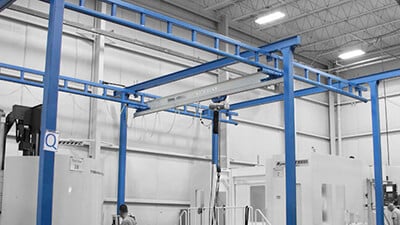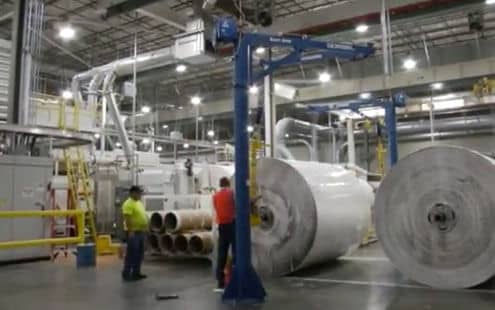
Workstation Cranes
Typically, when someone mentions an overhead crane in conversation it conjures up an image of a motor truck crane, a construction tower crane, or a heavy-duty motorized bridge crane pouring molten metal in a foundry. Workstation cranes have become a very hot topic of conversation as they have worked their way into assembly operations, warehouses, and manufacturing facilities over the last 40 years. As the U.S. tries to recapture manufacturing capabilities, new industrial crane technologies had to develop in order to allow fewer individuals to generate the same amount of productivity as multiple workers in overseas factories. Workstation cranes bring new advantages into the manufacturing and assembly world, including the following:
1. Greater Design Strength
Workstation Cranes are engineered with greater design strength instead of simply adding more steel. With a truss designed system, for example, the lighter dead weight of the system allows the operators to move the product while having to exert less energy to move the crane.
2. Precise Load Positioning
Precision sealed-for-life bearings allow the system to roll easier and allow precise positioning of the load, versus having to anticipate a stopping point with the electrical controls of a powered crane.
3. Strong Track Record
Workstation cranes have been in the market now for over 30 years. With that history, manufacturers have a strong track record that allows some manufacturers to put a 10-year warranty on their product.

Gorbel Easy Arm
4. Smart Lifting Devices Make Lifting Easier
Smart or intelligent lift devices are now available, offering speed and accuracy of load positioning, which adds to the return on investment. With lifting speeds up to 200 feet per minute and virtual limits for positioning, these devices greatly surpass the efficiency of normal hoists.
5. Assemble Parts in a More Ergonomic Position
Special tooling is also now available for both hoists and intelligent lift devices to integrate gripping components. These provide the benefit of allowing you to assemble parts without damaging them, and the operator can handle the parts in a more ergonomic position.
6. Increases Productivity and Reduces Risk of Injury
Return on investment can be figured easily with time studies to show increased productivity up front, and future returns can be seen with reduced injuries and fewer workman compensation claims.
7. Configurable to Your Unique Operation
Workstation cranes are also configurable in many different ways. They can be hung from the ceiling, assuming the structure can handle the load. They can also be supported with a freestanding structure that only requires a 6″ thick reinforced concrete floor. And depending on the facility’s layout, Workstation cranes can even be installed as a mixed system that is partially ceiling hung and the remainder a freestanding crane.
8. Flexibility as Your Factory or Process Changes
Workstation cranes can be reconfigured, so as your factory adapts and your processes change, the cranes can adapt along with those changes and be repurposed into your new layout.
For over 80 years, RMH Systems Material Handling and Lifting Solutions Experts have been dedicated to helping customers work safer and more efficiently. Whether you need innovative automation solutions, reliable material handling equipment, or expert advice, our team is here to assist you. Contact us today to discover how we can optimize your operations and drive success together. Contact us at 1.800.851.4995 or fill out our online form to request help..
